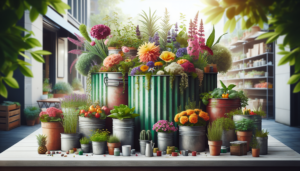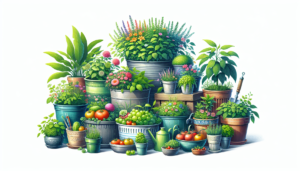
Are you a proud green thumb enthusiast? If so, we’ve got some exciting news for you! In this article, we’re going to share the top container gardening jobs that will not only satisfy your plant-loving soul but also bring a touch of nature to your outdoor space. Whether you’re a seasoned gardener or just starting out, these jobs will provide you with endless joy as you watch your plants thrive and bloom right before your eyes. So grab your gardening tools and get ready to embark on a delightful journey of container gardening!
Flower container arrangements
Flower container arrangements are a delightful way to add color and beauty to any outdoor or indoor space. Whether you have a spacious garden or a small balcony, you can create stunning floral displays that will brighten up your surroundings. Here, we will explore the various aspects of flower container arrangements to help you create eye-catching and vibrant displays.
Choosing the right flowers
When it comes to choosing flowers for your containers, there are a few factors to consider. Firstly, you need to think about the sunlight requirements of your chosen plants. Some flowers thrive in full sun, while others prefer partial shade. Take a look at the area where you plan to place your containers and assess the amount of sunlight it receives throughout the day. This will help you select flowers that will flourish in that specific location.
Another consideration is the color scheme you want to achieve. Think about the overall look and feel you want to create with your containers. Do you prefer a harmonious composition with colors that complement each other, or do you want a bold and vibrant mix of contrasting hues? By selecting flowers in different shades and textures, you can create visually appealing arrangements that will capture attention.
Lastly, consider the blooming season of the flowers you choose. Some plants bloom in spring, while others flourish in summer or autumn. By selecting a combination of flowers with staggered blooming periods, you can ensure that your containers will have continuous color throughout the year.
Creating beautiful color combinations
Color is the key to creating visually stunning flower container arrangements. When selecting flowers, consider the color wheel and use it as a guide to create harmonious or contrasting color combinations.
For a harmonious color scheme, select flowers in shades that are next to each other on the color wheel. For example, pairing pink and purple flowers or yellow and orange blooms creates a visually pleasing and soothing effect. This works especially well for creating a peaceful and tranquil ambiance in your outdoor space.
If you prefer a more vibrant and eye-catching display, opt for contrasting colors. Pair flowers that are opposite each other on the color wheel, such as purple and yellow or red and green. This will create a lively and energetic atmosphere in your garden or patio.
To add depth and dimension to your arrangements, consider incorporating flowers in different textures and heights. Combine delicate and wispy blooms with bold and structured ones to create an interesting mix of shapes and forms. This will add visual interest and create a dynamic composition that captures attention.
Arranging flowers for different seasons
One of the joys of container gardening is the ability to switch up your arrangements according to the changing seasons. By selecting flowers that thrive in specific seasons, you can create ever-changing displays that reflect the beauty of nature.
In spring, opt for flowers like tulips, daffodils, and pansies, which bring a burst of color and freshness after the long winter months. These flowers are known for their vibrant hues and delicate petals, making them perfect for creating cheerful and inviting container arrangements.
As summer approaches, choose flowers that can withstand the heat and thrive in full sun. Geraniums, petunias, and marigolds are excellent choices for summer containers. Their bright and bold colors combined with their heat tolerance make them ideal for creating dazzling summer displays.
When fall arrives, embrace the warm and earthy tones of the season. Select flowers such as mums, asters, and sedums, which are known for their rich autumnal colors. Pair them with foliage plants like ornamental grasses or colorful berries to create stunning arrangements that celebrate the beauty of the season.
By adjusting your flower container arrangements to match the seasons, you can enjoy a garden bursting with color and vitality throughout the year.
Herb container gardening
Herb container gardening is a fantastic way to grow your own herbs even if you have limited space. Whether you have a small balcony, a sunny window sill, or a tiny backyard, you can cultivate a variety of herbs that will add flavor and freshness to your culinary creations. In this section, we will explore the different aspects of herb container gardening to help you get the most out of your herb garden.
Selecting the best herbs for containers
When it comes to selecting herbs for your containers, there are several factors to consider. Firstly, think about the herbs you use most frequently in your cooking. By growing herbs that you regularly use, you can ensure a steady supply of fresh and flavorful ingredients.
Another consideration is the size of the plant. Some herbs, like basil and parsley, have compact growth habits and are well-suited for smaller containers. Other herbs, such as rosemary and thyme, can grow quite large, so you might need larger pots to accommodate their growth.
Additionally, consider the sunlight requirements of your chosen herbs. Most herbs prefer full sun, so make sure your chosen location receives at least six hours of direct sunlight each day. If you have limited sunlight, opt for herbs that can tolerate partial shade, such as mint or chives.
Lastly, think about the growth habit of the herb. Some herbs, like mint or lemon balm, can spread rapidly and might require regular pruning or containment. If you are concerned about the herb taking over your container, consider planting it in a separate pot or using a root barrier to control its growth.
Designing an herb container garden
Designing an herb container garden can be a fun and creative process. Consider the aesthetic appeal of your containers and how they will fit into your overall garden design. You can choose from a variety of containers, including traditional clay pots, decorative ceramic planters, or even repurposed containers like old teapots or tin cans.
To create a visually appealing herb garden, consider arranging the containers in an interesting and balanced way. You can place them in a row, creating a linear display, or group them together in clusters for a more relaxed and organic feel.
When it comes to planting your herbs, ensure that each container has proper drainage to prevent waterlogging. Fill the containers with well-draining potting soil and plant each herb according to its specific requirements. Pay attention to spacing guidelines to avoid overcrowding and to allow each herb to grow to its full potential.
If you have limited space, consider vertical gardening techniques. Install a vertical planter or use hanging baskets to maximize your growing area. This will not only save space but also create a beautiful and functional display.
Maintaining and harvesting herbs
Proper maintenance is essential to keep your herb container garden healthy and productive. Regular watering is crucial, as herbs in containers tend to dry out more quickly than those planted in the ground. Water your herbs when the top inch of soil feels dry, but avoid overwatering, as this can lead to root rot.
Fertilize your herbs regularly to provide them with the necessary nutrients. Use a balanced organic fertilizer or opt for slow-release granules that will gradually release nutrients over time. Follow the instructions on the fertilizer package to ensure you apply the correct amount.
Pruning and harvesting your herbs is not only important for maintaining the plants’ health but also for ensuring a bountiful harvest. Pinch back the tips of your herbs regularly to encourage bushier and more compact growth. This will result in more foliage and a better yield.
When it comes to harvesting, use clean and sharp scissors or pruners to prevent damaging the plants. Harvest early in the morning when the oils in the herbs are most concentrated for the best flavor. Regular harvesting will also encourage continuous growth, ensuring a steady supply of fresh herbs throughout the season.
By following these guidelines for herb container gardening, you can enjoy a diverse and flavorful herb garden right at your fingertips.
Vegetable container gardening
Vegetable container gardening is a great option for those who want to enjoy the flavors of fresh homegrown produce but have limited space or unsuitable soil conditions. Whether you live in an apartment, have a small yard, or simply want to utilize your patio or balcony, vegetable container gardening allows you to grow a wide range of vegetables in containers. In this section, we will explore the different aspects of vegetable container gardening to help you create a productive and rewarding garden.
Choosing suitable vegetables for containers
When selecting vegetables for container gardening, it’s essential to choose varieties that are well-suited to growing in pots. Look for compact or bushy varieties that don’t require extensive space or trellising.
Leafy greens like lettuce, spinach, and kale are excellent choices for container gardening. They have shallow root systems and can thrive in smaller pots. Tomatoes can also be grown in containers, but choose determinate varieties that are more compact and don’t require staking.
Other suitable vegetables for containers include peppers, eggplants, radishes, beans, and herbs like basil and parsley. Additionally, consider experimenting with vertical gardening techniques in containers to maximize your space. Cucumbers and peas, for example, can be grown on trellises or tomato cages.
Creating an efficient layout for vegetable containers
To make the most of your space, create an efficient layout for your vegetable containers. Consider the size and growth habits of your chosen vegetables when arranging them. Place taller plants towards the back or center of the container, so they don’t shade smaller plants.
You can also utilize tiered plant stands or shelves to create vertical gardening opportunities. This will not only save space but also provide better air circulation and sunlight exposure for your plants.
When planting, ensure that each container has proper drainage holes to prevent waterlogging. Fill the containers with high-quality potting soil that is rich in organic matter and provides good drainage. This will promote healthy root growth and nutrient uptake.
Nurturing and caring for container-grown vegetables
Proper care is crucial to ensure the success of your vegetable container garden. Regular watering is essential, as containers tend to dry out more quickly than the ground. Monitor the moisture level of the soil and water your vegetables when the top inch feels dry. Avoid overwatering, as this can lead to root rot.
Fertilize your container-grown vegetables regularly to provide them with the nutrients they need for healthy growth. Use a balanced organic fertilizer or slow-release granules that will gradually release nutrients over time. Follow the instructions on the fertilizer package to ensure proper application.
Pest and disease management is another important aspect of caring for container-grown vegetables. Regularly inspect your plants for signs of pests or diseases, such as chewed leaves, yellowing foliage, or powdery mildew. Use organic pest control methods, such as hand-picking insects or using insecticidal soap, to manage pests. If necessary, remove infected plants to prevent the spread of diseases.
Harvest your vegetables when they are fully mature and ripe. Different vegetables have different harvesting times, so refer to the seed packet or plant label for specific instructions. Use clean and sharp pruners or scissors to harvest the vegetables to prevent damage to the plants.
By following these guidelines for vegetable container gardening, you can enjoy a bountiful harvest of fresh and flavorful vegetables, no matter how limited your gardening space may be.







